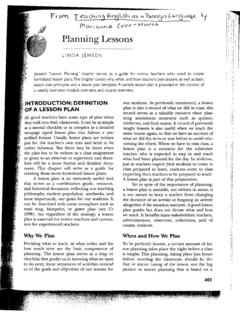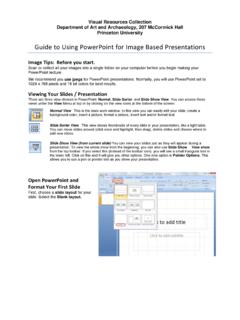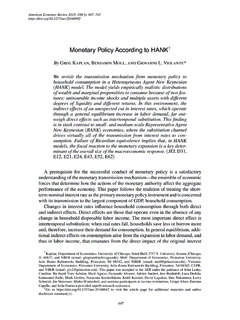Transcription of Chapter ENERGY STORAGE - Princeton University
1 - .. Chapter XlENERGY STORAGEC hapter Xl. ENERGY STORAGEPagePageMajor Design Choices .. 429 Appedix Xl-A..487 Thermal STORAGE ..432 Appendix Xl-B..488 Overview ..432 Low-Temperature STORAGE 0oto 150 C(32oto 302 F) ..432 Sensible-Heat STORAGE in Water..432 Sensible-Heat in Rocks..441 Latent-Heat, Low-Temperature STORAGE ..442 Concentrated Solutions ..445 Thermal STORAGE at lntermediate andHigh Temperatures ..447 Refractory Bricks..447 Steel Ingot STORAGE ..449 Heat-Transfer Oii Thermal STORAGE ..451 Refined Fuel Oii Thermal STORAGE ..451 Latent-Heat Systems..453 Environmental Concerns ..458 Thermochemical STORAGE ..459 Background ..459 Design Alternatives..461 Summary ..464 Electric STORAGE .
2 464 Mechanical STORAGE devices ..466 Battery STORAGE ..469 Lead-Acid Batteries..470 Advanced Batteries..472 Power Conditioners..477 Design Alternatives..477 System Performance..480 Appendix Xl-C..*..496 LIST OF TABLEST able Proposed Thermal STORAGE Materials ..4332. Phase-Change TEC Materials in the Low-Temperature Regime With Melting PointsAbove 75 C (167oF) ..4433. Candidate High-Temperature Thermal-EnergyStorage Materials Without Phase Change .4494. Commercial Organic and inorganic Heat-Transfer ..4525. Properties of Latent-Heat Thermal StorageMaterials ..4566. Candidate Chemicat- ENERGY StorageReactions ..4627. Conventional Hydroelectric CapacityConstructed and Potentiai at ExistingDams..4698.
3 Economic Specification (5-hr Battery) ..4719. Load-Leveling Battries: Candidates andCharacteristics; Developers and Demonstra-tion Dates ..47310. Loss Mechanisms of iron-REDOXB atteries ..47711. System Cost Estimates for Near-,Battery System Costs..481 Intermediate-, and Long-Term ..482B-1. Thermal Properties of Soils ..492C-1. Assumptions for Hot Fuel Oil ThermalStorage, Single Family House .. 498C-2. Assumptions for Therminol-55/RockThermal STORAGE .. 498C-3. Assumptions for Steel-Ingot ThermaiEnergy STORAGE .. 500C-4. Containment Materials .. 501C-5. Latent-Heat STORAGE Tank Assumptions.. 501C-6. Assumptions for NaOH Latent-HeatStorage .. 502C-7. Assumptions for NAF/MgF2 Latent-HeatStorage .. 502 LIST OF FIGURESF igure Possible Locations for STORAGE Equipmentin Onsite Solar ENERGY Systems.
4 4302. Vertical Tank in a Drilled Hole With Foamed-in-Place Insulation .. 4343. Installation of insulated, Underground, StorageTank at Solar Heated and Air-ConditionedBurger King, Camden, ..4354. installation of Fiberglass UndergroundTanks .. 4365. Cost of Buried Tanks .. 4376. Megatherm Pressurized-Water Heat-StorageTank ..4397. Predicted Performance of an Aquifer Usedfor Thermal STORAGE ..4408. Potential Sites for Aquifer StorageSystems .. 4419. Osmotic Pressure Engine .. 44610. Heat of Mixing Engine .. 44711. Low-Temperature Thermal STORAGE Costper kWht Versus STORAGE Capacity ..44812. A High-Temperature Thermal StorageDevice Designed for Residential Use ..45013. Steel-ingot, Sensibie-Heat STORAGE System 45014. Steei-ingot Temperature Profiles at VariousTimes in a Typical Cycle.
5 45015. The High-Temperature Heat STORAGE Systemat the Sandia Total ENERGY Experiment.. 45416. Design of Therm-Bank Space Heater , .. 45417. Philips Latent-Heat STORAGE System WithVacuum Multifoil Insulation..45518. Thermodynamic Behavior of CandidateLatent-Heat STORAGE Salts ..45719. Use of a Sodium Heat Pipe With a Latent-Heat High-Temperature Thermal StorageSystem .. 45820. Typical Thermochemical StorageTechnique ..46021. High-Temperature Thermal STORAGE Costper kWht Versus STORAGE Capacity ..46522. An isometric View of an UndergroundPumped STORAGE Plant ..46723. Conventional Hydroelectric Capacity Poten-tial at Existing Dams..46824. iron-REDOX Battery Structure and PlumbingDiagram .. 47625. Model of iron-REDOX Battery Facility.
6 47826. The Elements of a Power ConditioningSystem .. 47927. Efficiency of a Solid-State Inverter as aFunction of Load .. 48028. Power-Conditioning Cost Versus Power .. 483A-1. Permissible Cost of STORAGE Equipmentas a Function of ENERGY Prices DuringStorage Charge and Discharge ..487B-1. Thermal Conductivity of Insulation..490B-2. Annual Thermal Losses From UninsulatedStorage Tank .. 493B-3. Rate of Heat-Loss to Ground ..493 Chapter XlEnergy StorageMAJOR DESIGN CHOICESE nergy can be stored in thermal form by heating or chilling liquids orsolids; in mechanical form by using mechanical or electrical ENERGY to pumpwater to high reservoirs, spin flywheels or compress air; and in chemical formby driving battery reactions, producing hydrogen or other chemicals to gener-ate heat, or by distilling solutions.
7 This Chapter discusses a range of storagetechnologies which could have a major impact on the cost and performanceof onsite solar ENERGY systems during the next 10 to 20 years; it does not at-tempt to review all possible STORAGE of these approaches require specialized STORAGE equipment, but insome cases it may be possible to integrate STORAGE into mechanical struc-tures which serve other functions. Careful architecture can increase the in-herent ability of walls and floors, for example, to store thermal can be stored at a variety of points in an onsite solar system andsome of the opportunities are presented in figure Xl-1. The options for theheat engine system are most complex:1.
8 ENERGY can be stored at relatively high temperatures before it is used bya heat engine. In this form, high-temperature STORAGE is equivalent to of fossil rejected by the engines can be stored at relatively low generated by the system can be stored in batteries or otherelectric STORAGE unlikely that all three types of STORAGE would be used in a single in-stal I at systems can provide a useful buf-fering role,regardless of whether solarenergy is used, since the timing of demandsand the timing of generation desirable forpeak performance of generating equipmentseldom coincide, Most of the equipment dis-cussed in this Chapter was developed for sys-tems in which solar ENERGY played little orno of the uses of STORAGE are:1.
9 STORAGE in solar devices can be used toprovide ENERGY during cloudy periodsand at night. STORAGE can also be usedto facilitate starting large solar turbinesystems in the morning by preheatingthe equipment and to allow a gradualcooling of the system when it is closedat night. It can also mitigate the rapid ,temperature changes which can resultfrom sudden fluctuations in the Sun sintensity during periods of STORAGE equipment can be used tomake more effective use of generatingequipment. As noted earlier, withoutstorage the output of generating equip-ment must be continuously adjusted tomeet fluctuating demands. This meansthat generating equipment is either idleor operating at part capacity much ofthe time resulting in higher electriccosts since capital charges must bepaid on the equipment, even if it is notused.
10 Operating plants frequently below full capacity also means that the429 430 l Solar Technology to Today s ENERGY NeedsFigure Xl=1. Possible Locations for STORAGE Equipment in Onsite Solar ENERGY SystemsThermalCollectorThermalLoadsLowTe mperatureStorageIAThermalCollectorChemic al TransportHighTemperatureStorageHeatEngin ePhotovoltaicCellsCellCoolingILowTempera tureStorageElectricLoadsThermalLoadsHot Water TransportElectricElectricStorageTemperat ureStorageIITransportElectricLoadsTherma lLoadsThermal TransportCh. Xl ENERGY STORAGE l 431generators are not operating at peak ef-ficiency. Most large coal and nuclearplants cannot readily be adjusted tomeet changing loads; demand fluctua-tions must be met with generatingequipment which burns oil or gas fuels which are becoming scarce capacity can be reduced withstorage equipment if the STORAGE is filledwhile capacity exceeds demand, and dis-charged during periods of high demand.



















